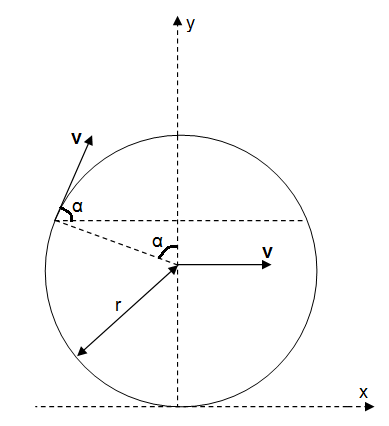Or search by topic
Number and algebra
Geometry and measure
Probability and statistics
Working mathematically
Advanced mathematics
For younger learners
Bike



- Problem
- Getting Started
- Student Solutions
As suggested in the hint it is useful to choose the coordinate system with the origin at the wheel touching the ground point. The wheel is moving horizontally with the speed $v = 18\mathrm{kmh}^{-1} = 5\mathrm{ms}^{-1}$ and the diameter of the wheel $d = 23 \mathrm{inch} = 0.584\mathrm{m}$. Note $r = d/2$. The wheel is not slipping on the ground, thus the linear speed of the drops on the wheel is $v = 5\mathrm{ms}^{-1}$. Suppose that the drop detaches when it is at an angle $\alpha$ with vertical.

In x direction: $x(t) = -r\sin(\alpha) + vt + vt\cos(\alpha)\;.$
In y direction: $y(t) = r + r\cos(\alpha) + vt\sin(\alpha) - \frac{gt^2}{2}\;.$
We neglect any air resistance then the drop will be at its highest point when its vertical speed is zero.
$$0 = v\sin(\alpha) - gt_{max}$$
Hence, $t_{max} = \frac{v\sin(\alpha)}{g}$. We substitute this expression to the y direction equation to get that
$$y(\alpha) = r(1 + \cos(\alpha))+\frac{v^2\sin(\alpha)^2}{g}-\frac{v^2\sin^2(\alpha)}{2g} = r(1 + \cos(\alpha)) +\frac{v^2\sin^2(\alpha)}{2g}\;.$$
Method 1. Differentiate y with respect to alpha and then solve $\frac{dy}{d\alpha} = 0$. Remember that $\frac{d\sin(\alpha)}{d\alpha} = \cos(\alpha)$ and $\frac{d\cos(\alpha)}{d\alpha} = -\sin(\alpha)$. We can use chain rule to differentiate $\sin^2(\alpha)$: $$\frac{d\sin^2(\alpha)}{d\alpha} = \frac{d\sin^2(\alpha)}{d\sin(\alpha)}\frac{d\sin(\alpha)}{d\alpha} = 2\sin(\alpha)\cos(\alpha)\;.$$ Moreover if C is constant $\frac{dC}{d\alpha} = 0$. Thus, $\frac{dy}{d\alpha} = 0 - r\sin(\alpha) + \frac{v^2}{2g}2\sin(\alpha)\cos(\alpha)$. This means that either $\sin(\alpha) = 0$ or $\cos(\alpha) =\frac{gr}{v^2}$ for $\frac{gr}{v^2} < 1$. If $\sin(\alpha) = 0$ then $\cos(\alpha) = 1$ or $-1$, $y_{max} = 2r = 0.584\mathrm{m}$ or $0$. If $\cos(\alpha) =\frac{gr}{v^2}$ for $\frac{gr}{v^2} < 1$ then $y_{max} = r\left(1+\frac{gr}{v^2}\right) + \frac{v^2}{2g}\left(1 -\frac{g^2r^2}{v^4}\right) = r + \frac{v^2}{2g} + \frac{gr^2}{2v^2} = 1.58\mathrm{m}$. So, the maximum height is $1.58\mathrm{m}$.
Method 2. Use identity $\sin^2(\alpha) = 1 - \cos^2(\alpha)$ and note $X = \cos(\alpha)$. Then $y(X) = r + rX + \frac{v^2}{2g} - \frac{v^2}{2g}X^2$ which is a quadratic and the critical point can be found. Try it!
Find the $x$ coordinate of the drops when they are at the highest point.
$$\begin{eqnarray} x_{max} &=& -r\sin(\alpha) + vt(1 + \cos(\alpha)) = -r\sin(\alpha) + v\frac{v\sin(\alpha)}{g}(1 + \cos(\alpha))\\ &=& \sin(\alpha)\left(\frac{v^2}{g}(1 + \cos(\alpha)) - r\right)\\
&=& \sqrt{1 - \frac{g^2r^2}{v^4}}\left(\frac{v^2}{g}\left(1 + \frac{gr}{v^2}\right) -r\right) =\frac{v^2}{g} \sqrt{1 - \frac{g^2r^2}{v^4}}
\end{eqnarray}$$
The coordinate of the wheel axle is $x_{axle} = vt = v\frac{v\sin(\alpha)}{g} = \frac{v^2}{g} \sqrt{1 - \frac{g^2r^2}{v^4}}$. Thus, $x_{axle} = x_{max}$. The drops are just above the wheel axle.
You may also like
High Jumping
How high can a high jumper jump? How can a high jumper jump higher without jumping higher? Read on...
Crazy Cannons
Two cannons are fired at one another and the cannonballs collide... what can you deduce?

